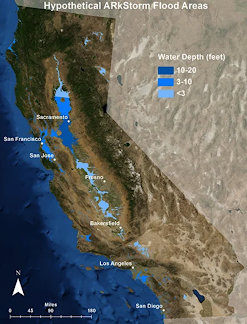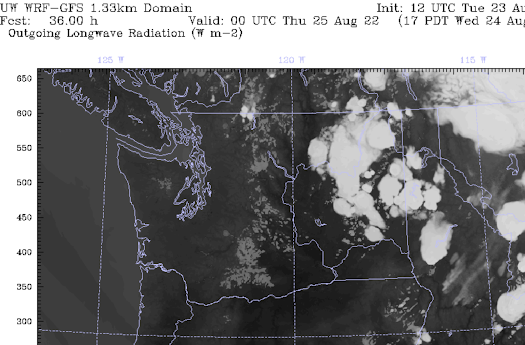If the nation is going to deal effectively with anthropogenic global warming, citizens must be provided with accurate information about the climate and how it is changing.
Unfortunately, the Seattle Times does not believe in communicating the facts but frequently provides deceptive, false, or exaggerated information.
Last week, a story--These areas of WA are likely to get hotter--but people keep moving there-- is a good example of the kind of problematic "journalism "coming out of the Seattle Times.
I will show you the deceptions in my blog below. Perhaps it takes a magician to show you the details of the deceptive "dark arts" of another. How information can be presented in a misleading way.The claim of this Seattle Times story is that there is an influx of new residents into areas (Tri-Cities) that will see a lot more severe heat waves during future decades.
How foolish of them! is the implied message.
The material in the article is not from some peer-reviewed research published in some prestigious journal. No...it is based on a report Hazardous Heat by a climate activist NGO called the First Street Foundation of Brooklyn NY.
The key graphic in the Seattle Times article is shown below, presenting the increase in the number of days above 90F during the next thirty years. As noted in the caption, this graphic is based on "models from the NY-based nonprofit First Street Foundation."
Wow. A HUGE increase in heat around the Tri-Cities, with OVER TWELVE more days above 90F. The center of the influx of new residents.
The Columbia Basin will be a virtually Hades of Heat according to this work, with most of it experiencing more than 9 more days above 90F.
How could people be so foolish to move into this region?, implies the Seattle Times.
Image courtesy of the Seattle Times
Some areas have no change (gray areas), including the north Cascades and even scattered regions in eastern Washington. This seems very strange...why would global warming skip these regions?
How did the First Street folks get these results? They started with global climate models driven by increasing greenhouse gases, and then did "statistical downscaling" to provide the higher resolution maps of temperature change.
What is really going on?
As I read the Seattle Times article and reviewed the First Street Hazardous Heat document, the problem with this "research" was immediately evident. Let me show you the "dark arts" used.
I went to the Climate Explorer website and plotted the climatological mean high temperatures during summer (this was for 30 years ending 1990).
Mama Mia! It looks a LOT like the Seattle Times plot of the change in the number of days above 90F during the next 30 years!
Temperatures are warmest in the lower elevations of the Columbia Basin. Also warm in the Willamette Valley, with lesser warm temperatures snaking into the SW Washington.
This general pattern, locked into place by terrain and the land-water contrasts of the region, was evident in a map of the mean maximum temperatures for the last 60 days this summer (see below).So according to the Seattle Times and First Street, there is going to be a huge increase in above 90F in just the regions that are already warm.
So global warming is going to avoid most of western Washington but really hit hard in the regions that are already hot.
This is simply nonsense. Folks moving to the Tri-Cities are not being ignorant and foolish. Let me prove this to you.
The Fallacy in the Seattle Times Story and the First Street Report
It is not an accident that the ST/First Street figure shows a big increase in 90F days where it is already hot. IT HAS TO BE THAT WAY. Such a figure tells you almost nothing about climate change.
But it is a good example of how picking an arbitrary threshold (in this case 90F) and determining how often you exceed it, is a totally flawed approach. Let me show you.
Imagine if global warming increases the temperatures over the entire region by 2F (very close to the warming over the past 50 years for the globe and the region).
So places that had lots of temperatures in the 88 and 89F range, hit 90F and are counted in the Seattle Times/First Street approach. But cooler places, WITH THE SAME AMOUNT OF WARMING, but fewer temperatures of 88/89F, would show far fewer (or NO) transitions to 90F.
So the methodology automatically suggests more of a major global warming problem in warm areas, but little in cooler areas, even with the same or even greater warming in the cool areas.
Want more proof?
Consider one year: 2020. Here are the number of days with high temperatures of 88 or 89F at Pasco in the Tri-Cities. THIRTEEN days.
But for Hoquiam, on the Washington Coast, ONLY One.
So warming by two degrees over the whole region will give 13 more "dangerous" events at Pasco and only one at Hoquiam.
Thus, in the Tri-Cities, a location highly accustomed to heat and where AC is everywhere, a few-degree warming and thus more transitions across the 90F barrier are worrisome, while along the coast, where AC is rare, warming is of little note.
And to beat a dead horse, here are the annual high temperatures in the Tri-Cities (Kennewick). No obvious upward trend.
You see why the Seattle Times story was so silly? And deceptive.
But there is more. The Seattle Times chose not to show another graphic found in the First Street report, a graphic that contradicts their storyline about the heat around the Tri-Cities.
First Street also analyzed the situation in a different way: instead of using the 90F threshold, they found the top 2% warmest days historically at every location and then determined how the number of days warmer than that changed with global warming over the next 30 years. These days are called "Local Hot Days".
The result is shown below. A VERY different map compared to the one shown in the Seattle Times. According to these results, the San Juan Islands will show the most warming with Whatcom and Skagit Counties right behind. Ironically, these are some of the mildest, most temperate parts of the State. No special warming for the Tri-Cities and eastern WA in this graphic!Graphic courtesy of First Street Foundation
End Note
The Seattle Times has an extensive history of inaccurate and hyperbolic reporting on climate change. With scary, unfounded headlines and poorly researched stories, they are failing to accurately inform local readers about this important topic.
The folks that should care most about this poor journalism are those most concerned about climate change.
Society can not properly deal with this issue if the true nature of the problem is not accurately described. How can we adapt to climate change if people don't understand the true threat? Hype and exaggeration not only turn people off from dealing with the issue but politize it in a way that can lead to division and inaction.
And hype/exaggeration damages the most psychologically vulnerable.
 There is no increasing trend of wettest 30-day events along the West Coast. Graphics courtesy of Professor John Christy
There is no increasing trend of wettest 30-day events along the West Coast. Graphics courtesy of Professor John Christy










.png)
.png)































